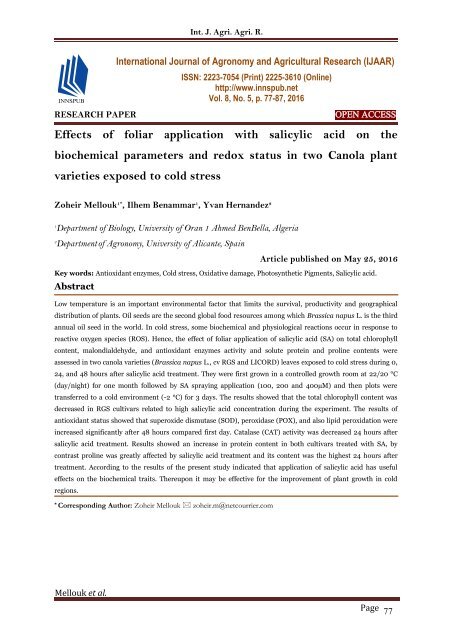IJAAR- an open access scholarly research journal of Agronomy and Agricultural Research, published an articles entitle of "Effects of foliar application with salicylic acid on the biochemical parameters and redox status in two Canola plant varieties exposed to cold stress" by Zoheir Mellouk, Ilhem Benammar, Yvan Hernandez from Department of Biology, University of Oran 1 Ahmed BenBella, Algeria 2 Departmentof Agronomy, University of Alicante, Spain
Abstract
Low temperature is an important environmental factor that limits the survival, productivity and geographical distribution of plants. Oil seeds are the second global food resources among which Brassica napus L. is the third annual oil seed in the world. In cold stress, some biochemical and physiological reactions occur in response to reactive oxygen species (ROS). Hence, the effect of foliar application of salicylic acid (SA) on total chlorophyll content, malondialdehyde, and antioxidant enzymes activity and solute protein and proline contents were assessed in two canola varieties (Brassica napus L., cv RGS and LICORD) leaves exposed to cold stress during 0, 24, and 48 hours after salicylic acid treatment. They were first grown in a controlled growth room at 22/20 °C (day/night) for one month followed by SA spraying application (100, 200 and 400µM) and then plots were transferred to a cold environment (-2 °C) for 3 days. The results showed that the total chlorophyll content was decreased in RGS cultivars related to high salicylic acid concentration during the experiment. The results of antioxidant status showed that superoxide dismutase (SOD), peroxidase (POX), and also lipid peroxidation were increased significantly after 48 hours compared first day. Catalase (CAT) activity was decreased 24 hours after salicylic acid treatment. Results showed an increase in protein content in both cultivars treated with SA, by contrast proline was greatly affected by salicylic acid treatment and its content was the highest 24 hours after treatment. According to the results of the present study indicated that application of salicylic acid has useful effects on the biochemical traits. Thereupon it may be effective for the improvement of plant growth in cold regions.
"" IJAAR welcome all of you to submit your research paper for publication in the field of Agriculture, Agronomy, Horticulture etc. Please submit your manuscripts via Online submission panel.""
Introduction
It is a well know that, low concentration of phytohormones could regulation the wide rang of growth and development process. However, the metabolic aspects of plants applied with phytohormones shifted to varied degrees depend on the plant type and action mode. Salicylic acid belongs to a group of plant phenolics which has an aromatic ring and natural product of phenylpropanoid metabolism. SA involved in plant growth, flower induction, and Termogenesis (Raskin, 1992). It also has lots of affects on ions uptake (Raskin, 1992). Enhancement of the content pigments photosynthetic rate (chlorophyll and carotenoids), and modifying the activity of some of the important enzymes are other roles of SA. In terms of stress physiology, SA was first demonstrated to play a role in responses to biotic stress and involved in signal transduction process of biotic stress tolerance. In addition, acts as a signal for development of hypersensitive reaction (Horváth et al., 2007). However, it was gradually found to have more effects that could be of importance for other stress. Several studies show the ability of SA to produce protective effects in plant response to abiotic stress factors. The results of several studies shown that exogenous application of SA can aid plant tolerance with many abiotic stresses, such as; induced increase in the resistance to salinity (Szepesi et al., 2005), low temperature (Janda et al., 1997), water deficit (Singh and Usha 2003), freezing (Tasgin et al., 2003), and heavy metal (Mishra and Choudhuri, 1999). Exogenous application reduced the inhibitory effect of heavy metal in rice (Oryza sativa L.) (Mishra and Choudhuri, 1999). In wheat, seeds were soaked in Acetyl salicylic acid; the plants had better resistance to drought stress (Singh and Usha 2003). In tobacco that growth in medium containing, SA caused to increased heat tolerance (Dat et al., 2000). It was shown that SA treatment applied to hydroponics growth solution of maize plants; provide protection against low temperature stress (Mishra and Choudhuri 1999). SA involved in resistance to stress form salinity for example in tomato plants (Szepesi et al., 2005). The genus Brassics is an important agriculture crop grown primarily for edible oil and used for various purposes, e.g., as vegetable, fodder, and condiments. Furthermore, it is known that Brassica species are significant plant for investigation in resistance of abiotic stress, especially cold resistance, and great advances have been made in term of cold induced genes and antioxidant mechanisms (Wang et al., 2007). In stress condition (low temperature especially), the primary target of damages related to the photosynthesis. In this situation, photoinhibition of photosynthesis is causes of the generation of Reactive Oxygen Species (ROS) in the thylakoid membrance. These free radicals are able to damage to protein and pigments photosynthetic. To alleviated or prevent damage of free radicals, plants have evolved mechanisms by accumulation of low molecular weight solutes (Horváth et al., 2007) and antioxidant compounds (Tasgin et al., 2003), such as; SOD, CAT, and POX that scavenge the ROS. SOD is metallo- enzymes that scavenge the toxic superoxide radicals and catalyze the conversion of two superoxide anions into oxygen and H2O2 (Qaiser et al., 2010). Then, CAT converts the H2O2 into water and oxygen. POD decomposes H2O2 by oxidation of cosubstrates, such as; phenolic compounds and antioxidants. The recent work was conducted in order to determined salicylic acid treatment and its effect in two canola varieties to give more information on the physiological traits under chilling stress. For this purpose, we investigated the change in enzymes activity status, proline accumulation, protein solution, lipid peroxidation and chlorophyll pigments to related them to defense strategies in each variety.
Get the full articles by following the link Int. J. Agr. Agri. Res. 8(5), 77-87.
Call for Paper | INNSPUB Jo... by International Network For N...















0 comments:
Post a Comment